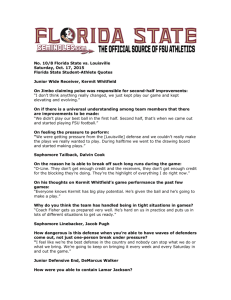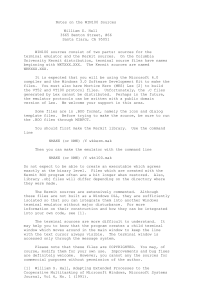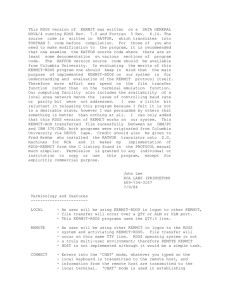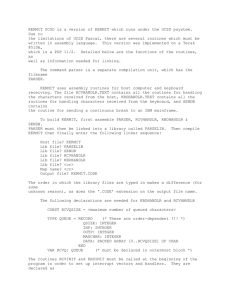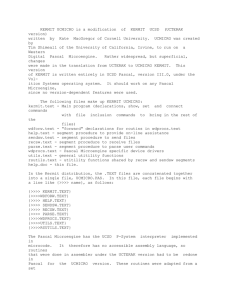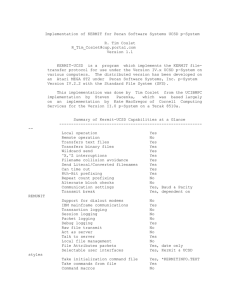M2 KERMIT is a modification of KERMIT UCSD... by Tim Shimeall of the University of ...
advertisement
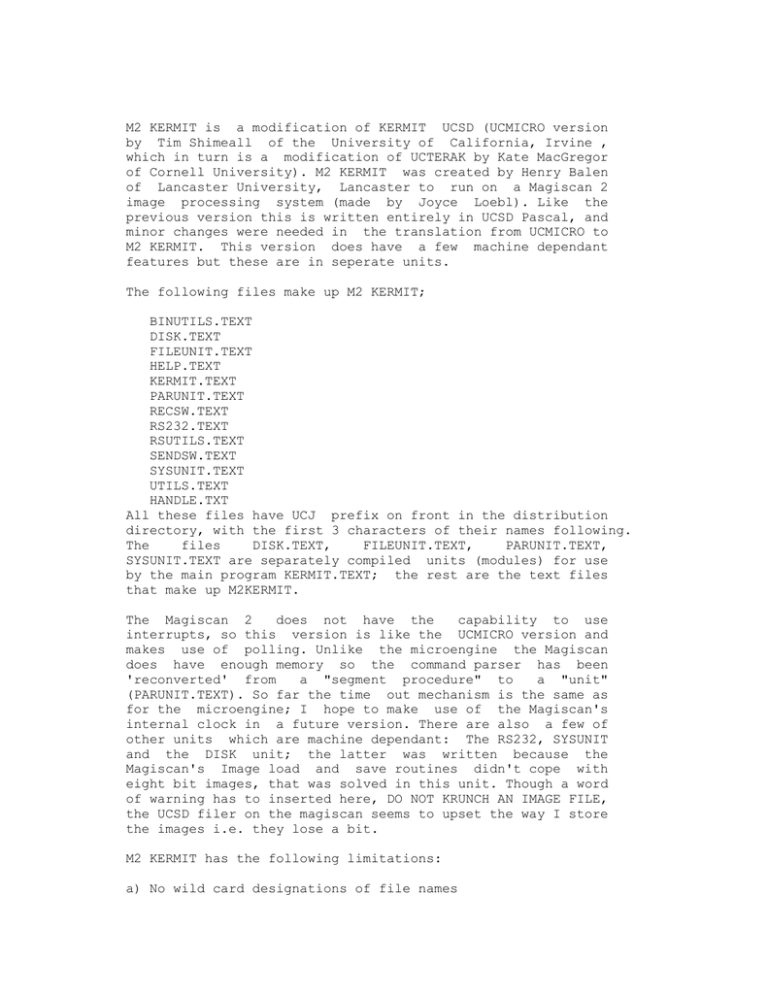
M2 KERMIT is a modification of KERMIT UCSD (UCMICRO version by Tim Shimeall of the University of California, Irvine , which in turn is a modification of UCTERAK by Kate MacGregor of Cornell University). M2 KERMIT was created by Henry Balen of Lancaster University, Lancaster to run on a Magiscan 2 image processing system (made by Joyce Loebl). Like the previous version this is written entirely in UCSD Pascal, and minor changes were needed in the translation from UCMICRO to M2 KERMIT. This version does have a few machine dependant features but these are in seperate units. The following files make up M2 KERMIT; BINUTILS.TEXT DISK.TEXT FILEUNIT.TEXT HELP.TEXT KERMIT.TEXT PARUNIT.TEXT RECSW.TEXT RS232.TEXT RSUTILS.TEXT SENDSW.TEXT SYSUNIT.TEXT UTILS.TEXT HANDLE.TXT All these files have UCJ prefix on front in the distribution directory, with the first 3 characters of their names following. The files DISK.TEXT, FILEUNIT.TEXT, PARUNIT.TEXT, SYSUNIT.TEXT are separately compiled units (modules) for use by the main program KERMIT.TEXT; the rest are the text files that make up M2KERMIT. The Magiscan 2 does not have the capability to use interrupts, so this version is like the UCMICRO version and makes use of polling. Unlike the microengine the Magiscan does have enough memory so the command parser has been 'reconverted' from a "segment procedure" to a "unit" (PARUNIT.TEXT). So far the time out mechanism is the same as for the microengine; I hope to make use of the Magiscan's internal clock in a future version. There are also a few of other units which are machine dependant: The RS232, SYSUNIT and the DISK unit; the latter was written because the Magiscan's Image load and save routines didn't cope with eight bit images, that was solved in this unit. Though a word of warning has to inserted here, DO NOT KRUNCH AN IMAGE FILE, the UCSD filer on the magiscan seems to upset the way I store the images i.e. they lose a bit. M2 KERMIT has the following limitations: a) No wild card designations of file names b) No character repeat counts c) No '?' and <esc> at the end of a command line. d) No server communications e) Only one file is sent at a time (a break packet is sent after each file). KERMIT M2 has been thoroughly tested in connections with VMS and BBC KERMIT, but errors may persist. In particular, since there are no interrupts in this version, characters may occasionally be lost. Character loss was observed with transfers from the BBC and the MUX delay had to be set to >= 4; this enabled a wait between transmision of characters from the BBC. A way round this would be to implement the receive and send packet routines in machine code, and possibly the terminal emulator, this would speed up the polling and hence reduce the likelyhood of character loss. The commands recognized by KERMIT M2 are a superset of those for KERMIT UCMICRO. I shall give the descriptions of the commands that I have added and you should refer to UCMICRO and TPKERM for the rest: SET BAUD <rate>: this command enables the user to set the Baud rate, the value of <rate> can be examined by doing a SHOW BAUD (or a SHOW ALL). SET DISK <vol>: this command enables the user to set the work disk to any valid UCSD block device (i.e #4,#5,#9,#10), the value of <vol> should be any of the following 4,5,9,10 dependant on which devices your machine has available. This can also be examined by use of the SHOW command. DIRECTORY: this command gives the directory of the current work disk, it gives an extended directory listing. DELETE <filename>: this command deletes the given <filename> from the work disk. TRANSFER TYPE <type>: this tells KERMIT what type of file transfer is going to take place, the choice of transfer types are TEXT, DATA, CODE, IMAGE. The first is the default, for IMAGE types an image has to be loaded using the LOAD command. LOAD <filename>: this loads an image (called <filename>) from the work disk, this can only be done if the transfer type is IMAGE.

